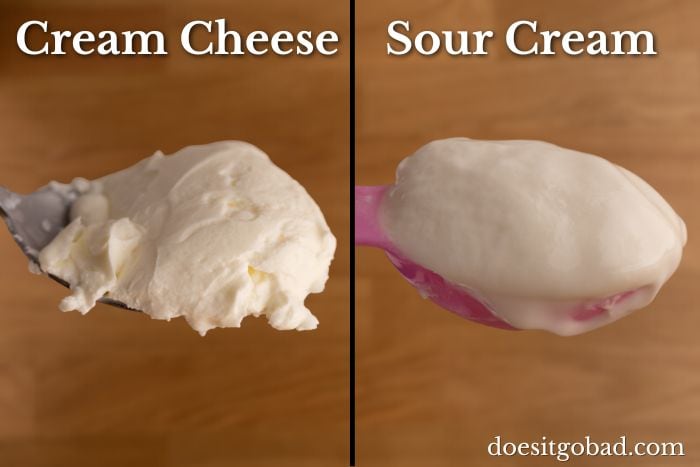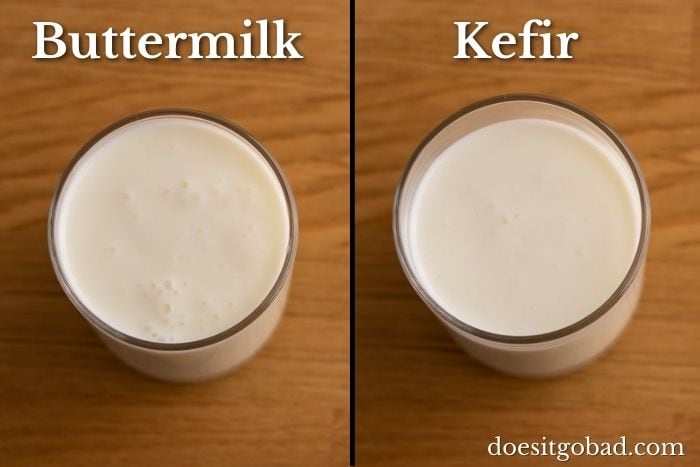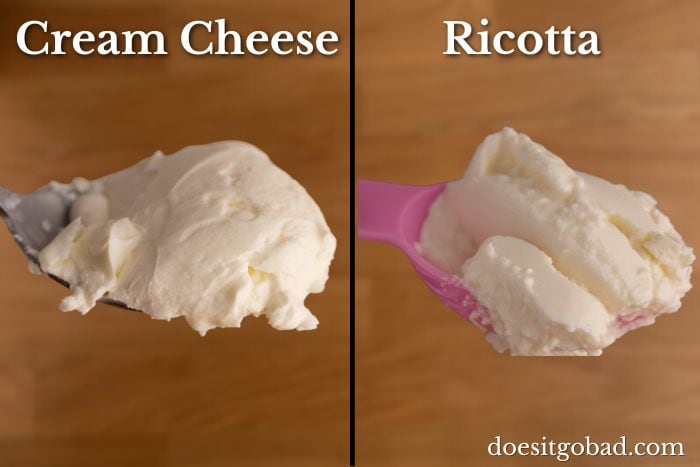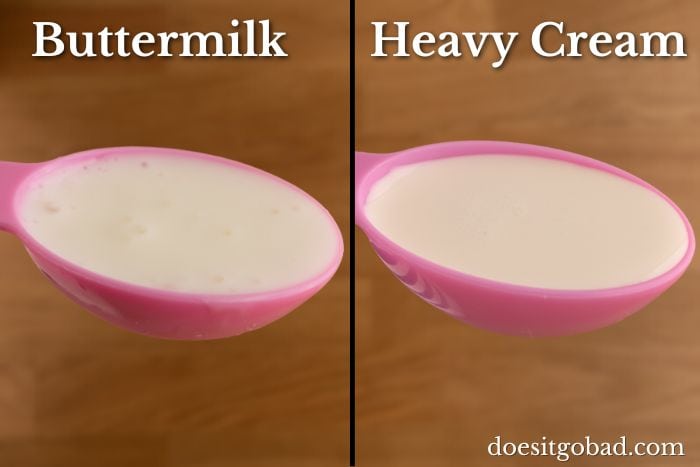Buttermilk vs. Sour Cream: Differences and When to Sub
Sour cream and buttermilk are used in similar dishes but have a few crucial differences. Buttermilk is somewhat thick and lumpy but pourable, while sour cream is thick and not pourable at all. Plus, sour cream typically contains more than five times more fat than buttermilk.
You can often substitute sour cream for buttermilk (with some added milk), but it’s not that simple the other way around.
Interested in learning about the differences, similarities, and when swapping makes sense?
If so, this article is for you. Read on.
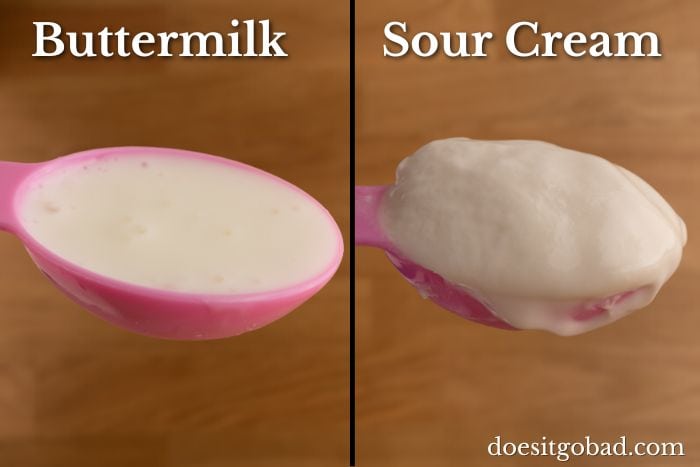
When to Substitute
Buttermilk and sour cream aren’t interchangeable, but swapping is an option in specific contexts.
It’s easier to sub sour cream for buttermilk because if you mix sour cream with milk, you get a mixture that’s quite similar to buttermilk.
Things are much more difficult the other way around because you can’t turn light and pourable buttermilk into a rich and creamy sour cream.
That’s the high-level overview. Next, let’s get into the details.
Can I Substitute Sour Cream for Buttermilk?
In many cases, you can sub sour cream for buttermilk.
To make “buttermilk” from sour cream, combine three parts sour cream with one part milk or water, whisk the mixture to combine, and see if the texture is right. If it’s still too thick, add more liquid.
The resulting mix won’t taste exactly like buttermilk, but it will be close enough and work okay in most cooked dishes.
(Kefir is a great substitute for buttermilk if you are looking for one.)
For example, to make 1 cup of this buttermilk-like liquid, you need to combine 1/4 of a cup of water with 3/4 of a cup of sour cream.
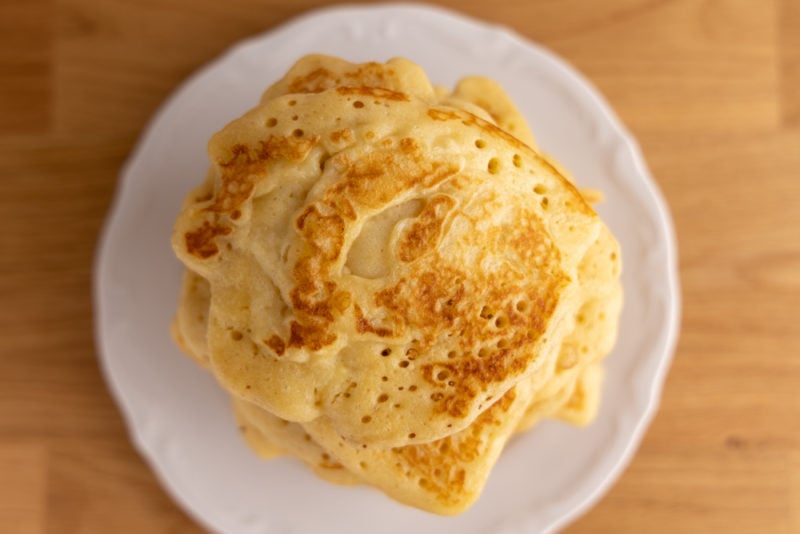
This mixture isn’t a perfect substitute and sometimes won’t do the trick. For instance, if you’d like to enjoy a glass of fresh buttermilk, swapping in that sour cream with milk mixture won’t be nearly as good.
But if you’re making pancakes, waffles, muffins, or anything else where buttermilk is part of the batter that’s then cooked or baked, the mentioned mixture should work okay.
You can also try swapping it in dressings and sauces, but in those, add only the sour cream, mix everything else in, and slowly add milk until the texture is just right. Follow this process because dressings and sauces aren’t as forgiving as cooked and baked goods.
Finally, keep in mind that sour cream is much more calorie-dense than buttermilk, so if you’re trying to limit your caloric intake, subbing in sour cream is a bad idea.
(Subbing heavy cream for buttermilk is an even worse idea if you’re worried about your caloric intake.)

Can I Substitute Buttermilk for Sour Cream?
Substituting buttermilk for sour cream highly depends on the dish you’re preparing, and there’s no simple ratio.
You can often make buttermilk work in cooked or baked dishes where sour cream is added to the batter. But if you need sour cream for a creamy sauce, to top your pie or cake, or need a couple of dollops for your roasted potatoes, buttermilk won’t do the trick.
In other words, it’s not a simple swap, and it’s usually easier to find a similar recipe that uses buttermilk instead of sour cream and use it instead. But if you’re up to the challenge and the dish you’re cooking is a low-stakes weeknight dinner that’s okay to mess up, feel free to give it a go.
(I hereby excuse you for ordering pizza if things go south.)
So if sour cream is used to add tanginess to something like pancake or muffin batter, or to activate baking soda in baked goods, here’s what you can try. Sub half a cup of buttermilk for every cup of sour cream, and see if the batter’s texture resembles what you’re looking for.
If it doesn’t, you can add more buttermilk to thin it out or more dry ingredients to make it thicker. You can also add an extra egg yolk or two to make up for the loss in fat content and to add some richness that buttermilk lacks.
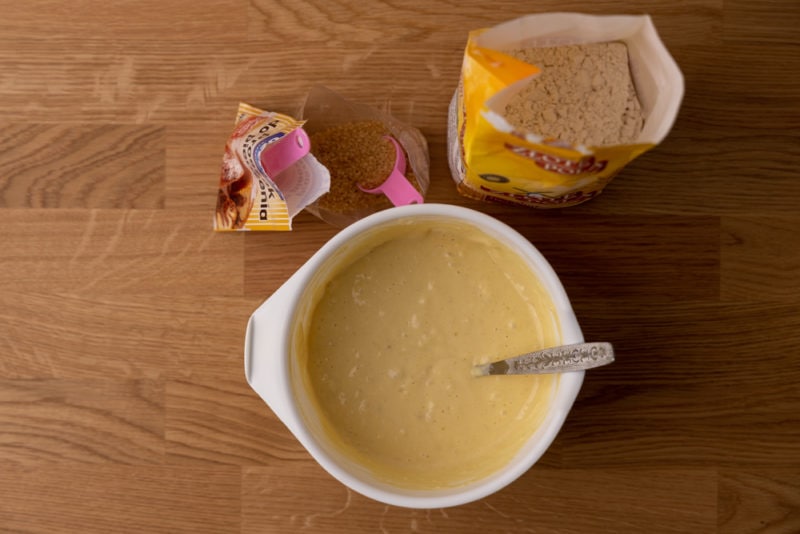
Another way to add more fat is to add more butter or oil, depending on what the recipe uses.
That said, subbing sour cream with buttermilk will likely result in a dish lacking richness and depth. And that’s going to be the case even if you get the texture of the batter right.
Anyway, what you’re trying to achieve here is to get the batter to the consistency it is supposed to have before you cook or bake it. And because of that, if it’s your first or second time with a recipe, it’s better to choose another one, as chances are you won’t get the texture right and will end up with a mediocre dish at best.
(The same is true if you’re trying to sub heavy cream for sour cream.)
Next, let’s discuss the differences and similarities between the two dairy products.
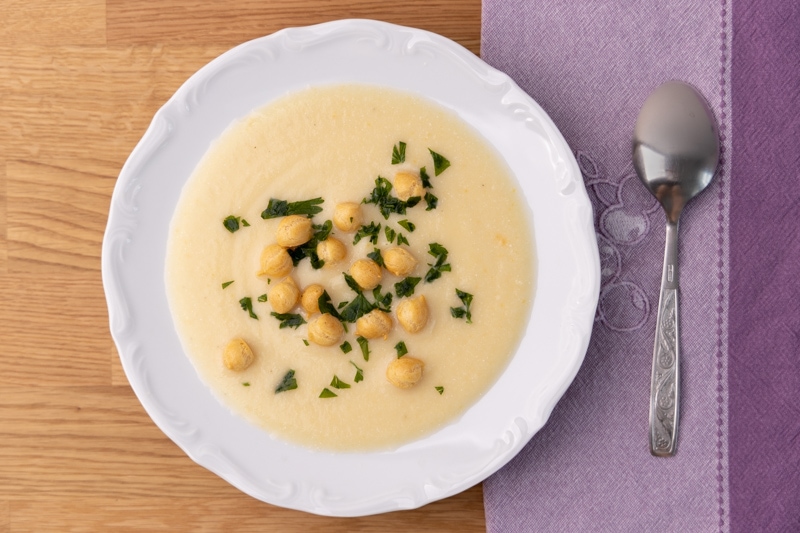
Buttermilk vs. Sour Cream: Differences and Similarities
There are some similarities between buttermilk and sour cream, but there are also some crucial differences that might make or break whatever you’re cooking. I divided everything into a few sections, so it’s easier to read about what you’re actually interested in and skip the rest.
Taste and Texture
Both buttermilk and sour cream have a similar, slightly tangy taste, though the latter tastes a bit more acidic. But the thing that differentiates the two is the texture.
Buttermilk is lumpy and a bit thicker than milk but still easily pourable. On the other hand, sour cream is like a thick yogurt that’s rich and creamy but not pourable at all.
Here’s how the two compare:
Because of the texture difference, subbing sour cream for buttermilk is often relatively easy – you just need some liquid to thin it out, and you’re good to go.
The other way around, things are much more difficult because you can’t make buttermilk rich and thick. By adding it instead of sour cream, you’re basically replacing the liquid content but without adding any richness. That’s why I suggest adding an extra yolk or two to make up for that.
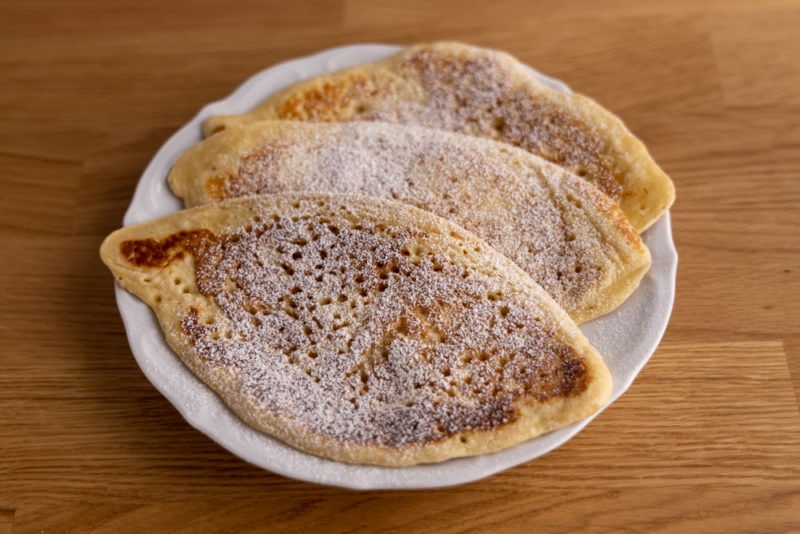
Uses
| Buttermilk | Sour cream |
|---|---|
| In baking muffins, biscuits, cakes, scones, and so on | Topping pies and cakes |
| In salad dressings (like ranch) | Dipping sauces and salad dressings |
| Drinking it straight | Making things more creamy (soups, mashed potatoes, etc.) |
| Cooked and baked goods like muffins, scones, pancakes, and cookies |
Buttermilk and sour cream have pretty similar uses, though the latter is arguably a bit more versatile. While buttermilk shines in baking, sour cream is not only great in baked goods but also often used in sauces and dressings, thanks to its richness.
Also, both products are acidic enough to activate baking soda, so don’t be surprised that baked goods that call for either usually use baking soda instead of baking powder.
(Baking powder provides its own acid to activate.)
Of course, both products have a couple of unique uses, too.
Buttermilk is often drank straight from the glass or added to cereals or granola. And in those settings, subbing it with sour cream (even mixed with some liquid) doesn’t work nearly as well as you’d like.
On the other hand, sour cream makes a great topping on its own (e.g., on roasted potatoes) or mixed with some sugar (e.g., on a cheesecake). And I’m sure you can imagine what a disaster would be to pour some runny buttermilk on roasted potatoes.
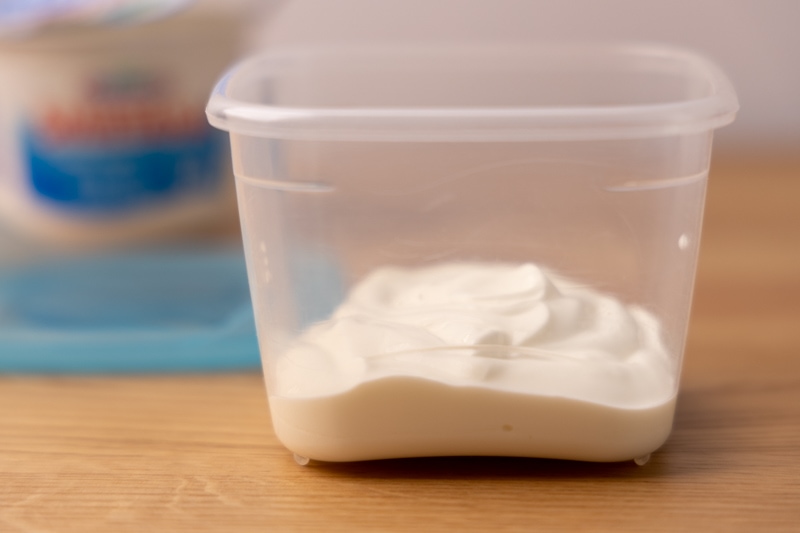
Nutrition
The macronutrient profiles of buttermilk and sour cream are fairly similar, except for the amount of fat. Here’s what they look like (per 100g):
| (per 100g) | Buttermilk [source] | Sour cream[source] |
|---|---|---|
| Energy | 43kcal | 198 kcal |
| Protein | 3.46g | 2.44g |
| Fat | 1.08g | 19.4g |
| Carbohydrates | 4.81g | 4.6g |
As you can tell, the protein and carbohydrate content are quite similar, but there’s like 5 to 20 times more fat in sour cream than in buttermilk. The exact number depends on whether you go with a full-fat or fat-reduced version of either.
(Buttermilk is most often sold fat-reduced, while for sour cream, you can find both full-fat and “light” varieties.)
Because of the disparity in fat content, sour cream is a much more calorie-dense option. So if you’re watching your fat intake (or overall calories), make sure you control how much sour cream you use.
Production
The production process for both buttermilk and sour cream is pretty similar. That’s because both are cultured dairy products, and lactic acid bacteria are added to both.
The main difference is the starting point. Buttermilk starts with milk, while sour cream starts with cream. That’s why buttermilk stays pourable and has little fat, while sour cream becomes thick and has lots of fat.
(I’m talking here about how buttermilk and sour cream are made nowadays, now how they were made way back when. Now the processes are standardized and streamlined, and there’s no guesswork involved.)
The production process looks something like this:
- We take the base liquid. In our case, it’s milk for buttermilk or cream for sour cream.
- We inoculate the liquid with lactic acid bacteria and let it ferment. The fermentation process is done at around room temperature and takes roughly between 12 and 36 hours. During the process, the added bacteria turn lactose (milk sugar) into lactic acid. That thickens the liquid and makes it sourer.
- Once the taste and texture are ideal, fermentation is stopped, and the liquid is refrigerated and bottled.
That’s a high-level description of the process, and the details vary a bit between brands. But it’s always pretty similar to the above, and if you’re not interested in digging into the nitty-gritty, that’s about enough you need to know about it.
The Bottom Line
Buttermilk and sour cream are fairly similar in taste, but the latter is way thicker and denser than the former. So while they’re used in similar dishes, they’re not interchangeable, and substituting one with the other isn’t that simple.
If you want to replace buttermilk with sour cream in a cooked or baked good, simply combining three parts sour cream with one part milk or water often does the trick. The other way around, things are much more complex, and it’s best to try only if you know well the dish you’re prepping.
Rotten Records: Share Your Snap!
Caught some food past its prime? Upload your photo to “Rotten Records” and help others spot the signs of spoilage. Every image makes our food community safer and more informed!
